Smashed at the Weekend #13
Eat fantastic Spanish food in Ealing, watch legendary Chicago chef Charlie Trotter and drink fine tequila cocktails by Tristan Stephenson
Somewhere to go: Rayuela
If you are a regular Smashed reader, you’ll know that I am not always respectful towards our esteemed national restaurant critics. However, sometimes they do nail it and that’s exactly what Giles Coren did with his review of Spanish restaurant Rayuela back in January 2024 (Smashed #12). He wrote about 5 year aged jamón ibérico that was ‘red-brown like an English apple’, and croquetas de jamón that were ‘crisp of shell, unctuous within’, ‘very good patatas bravas’ and pluma that was ‘soft and juicy and grilled crisp at the edges’.
Why it took me a year to follow in his footsteps, I’ll never know, but I eagerly accepted an invitation to lunch earlier this year. I had never been to Ealing before because I wasn’t previously aware of any reason to make the trek that far west, although I’ve recently added the Sir John Soane-designed Pitzhanger Manor and Gallery to my cultural to-do list. It’s not the most beautiful part of London, but the restaurant is sheltered from the very busy Ealing Broadway and Uxbridge Road by being tucked away in the modern Dickens Yard development. The Elizabeth Line means it’s a cinch to get to, even from Brighton.
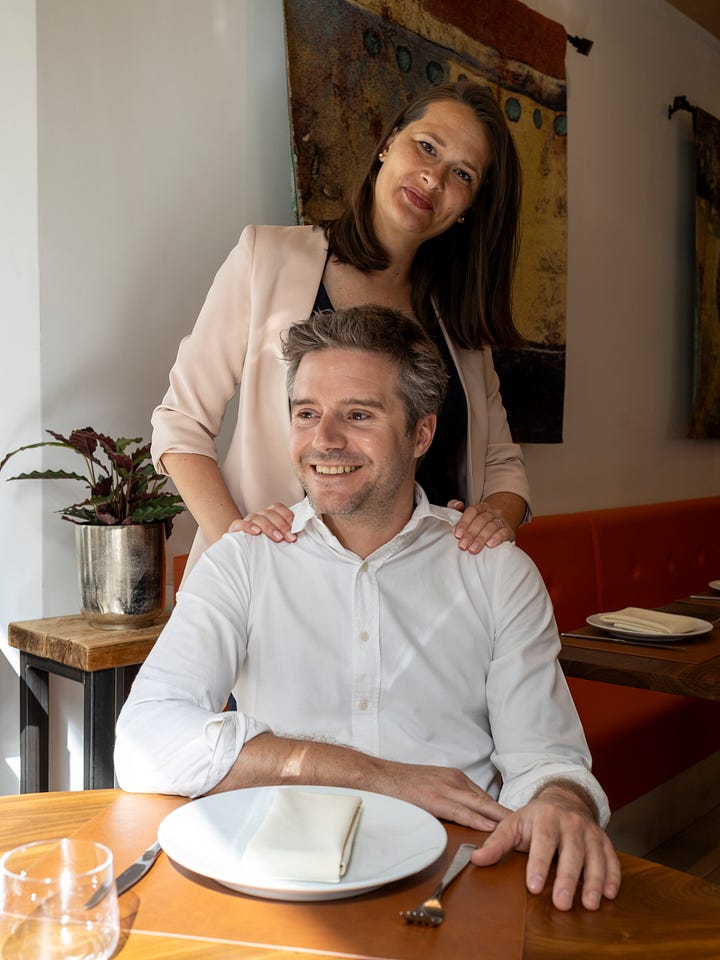
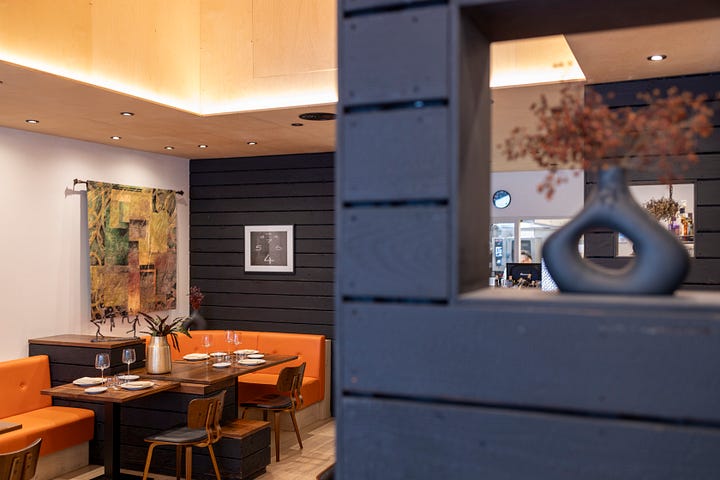
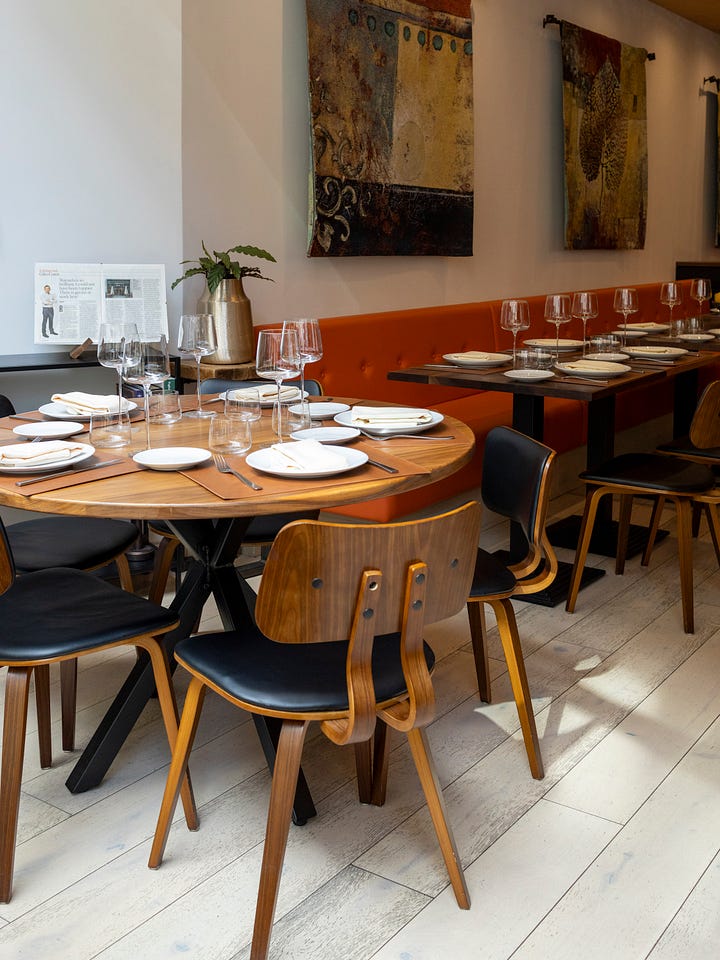
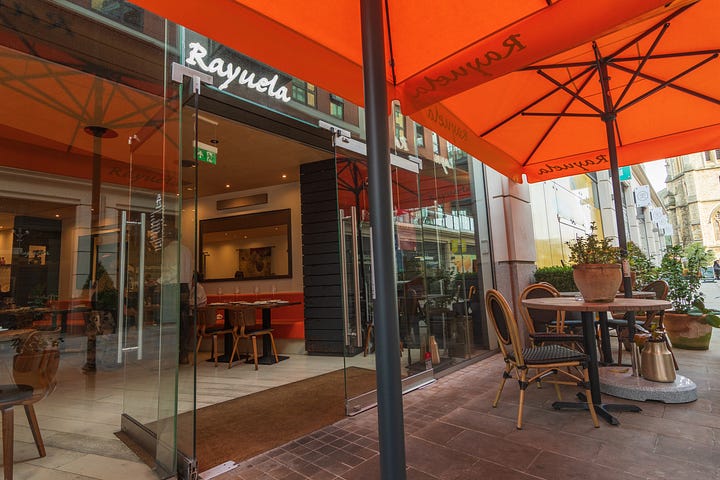
Owners Miguel Morales (former restaurant manager at London-based Spanish restaurant group Cambio de Tercio) and his wife Anastasiia opened Rayuela in 2022 following the success of their nearby wine bar Reineta. They’ve put some spirit into what could otherwise have been a soulless unit in the retail development to create a comfortable and convivial space, with vibrant orange banquette seating, an open kitchen and a portable carving table for that stunning aged jamón ibérico.
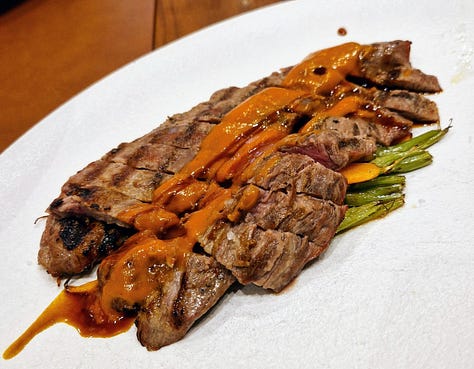
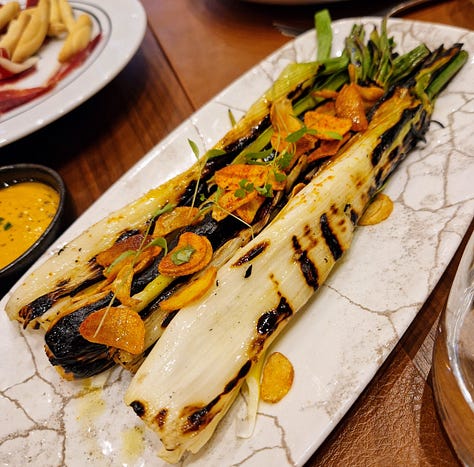
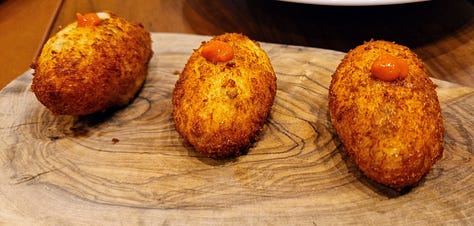
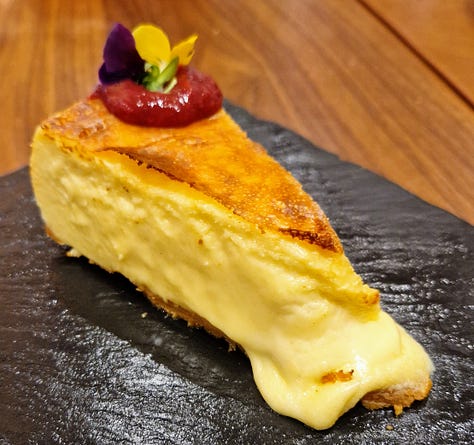
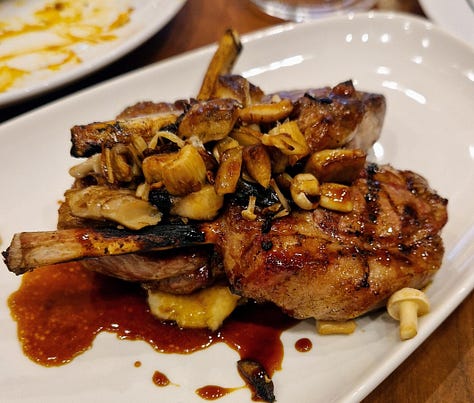

Rayulea means ‘hopscotch’. The restaurant’s website says, ‘At “Rayuela” the experience of having a meal becomes a game as the table transforms into a hopscotch court. By jumping from one dish to another we invite you to combine flavours to taste the variety of our menu at each hopscotch square.’ It’s the one thing I just don’t get about the place. Whatever the concept behind the menu, it doesn’t really translate in reality. True, there were a number of dishes on the table at any one time but that was no different from countless other small or sharing plates restaurants. Whatever, the odd marketing conceit didn’t detract from the high quality of the ingredients and cooking.
I could live on patatas bravas, and particularly Rayuela’s delicious version (although I have to give a shout out to the equally fabulous version served at the recently opened Amari in Brighton). The same goes for their textbook croquetas. Simple, humble dishes they may be, but because they are so well done, they are a proper culinary treat. There is some seriously skilled grill work going on at the restaurant with pluma Iberica served with a guava sauce (an influence from chef Andres Sanabria Quevedo's Colombian heritage), lamb chops, and calcots with romesco all cooked to perfection.
The selection of wines that included Herència Altés Benufet Garnacha Blanca from Terra Alta, Catalonia and Can Sumoi Xarel-lo 2023 from Penedès were interesting choices and great matches for the food.
Rayuela’s menu changes seasonally and there are already plenty of reasons to return, including secreto toast with miso glaze; mackerel ceviche with cucumber leche de tigre and cancha corn, and paella del senyoret. Service was terrific too, welcoming and clued up. I wouldn’t hesitiate to recommend the place. Rayuela makes Ealing groovy.
The Details
Rayuela, Unit 9C Dickens Yard, London, W5 2TD. 02045686659; rayuela.co.uk
Smashed was a guest of Rayuela
Something to watch: Love, Charlie
‘My philosophy has always been, if it weren’t for the employees and it weren’t for the customers, the restaurant business would be the greatest business in the world. And basically I hate people.’ So begins this riveting documentary of one of the most influential American chefs of the 20th century. Opened in 1987, Charlie Trotter’s eponymous Chicago restaurant introduced tasting menus to the American dining public. His focus on creative, spontaneous cooking not only helped make the city of Chicago a serious gastronomic destination, but paved the way for the likes of Thomas Keller. His influence spread beyond the states, with both Gordon Ramsay and Heston Blumenthal citing him as an influence. His series of glossy, large-format cookbooks helped spread his reputation internationally and set the template for many other chefs’ cookbooks to come.
The film traces Trotter’s life from his hyperactive childhood, growing up in the 60s in a wealthy family in Wilmette Illinois with a successful business man for a father (he ran an nationwide employment agency for IMB-trained people) and eating his mother Dona-Lee Trotter’s less than haute cuisine cooking (‘I am not a great cook,’ she admits on camera), to his untimely death in 2013 aged just 54. The film reveals a driven, complex man who was loved, admired and respected, but also reviled.
Interviewees include Chicago restaurateur Gordon Sinclair and chef Norman Van Aken of Gordon’s restaurant who gave Trotter his first job. Van Aken remained a lifelong friend of Trotter and wrote movingly about their relationship and his reaction to the documentary in his newsletter. There are also contributions from celebrity chefs Wolfgang Puck and Emeril Lagasse, but the key interviewees, apart from archive recordings of Trotter himself, come from his first wife Lisa Ehrlich and three-Michelin-starred Chicago chef Grant Achatz.
‘A lot of his drive and ambition and that edge he had was trying to make his father proud. His dad was an extremely successful businessman and I think that Chuck desperately wanted to show his father that he could do right by him and that he could be successful,’ says Ehrlich in one revealing comment. Trotter’s preoccupation with his restaurant led to Ehrlich divorcing him in 1990 and his all-consuming passion led to a very particular work environment for his employees. ‘There was just a tornado of energy in that kitchen that was mixed with extreme fear, and it was just insane,’ says Achatz, who first entered Trotter’s kitchen as a 20-year-old in the early 90s.
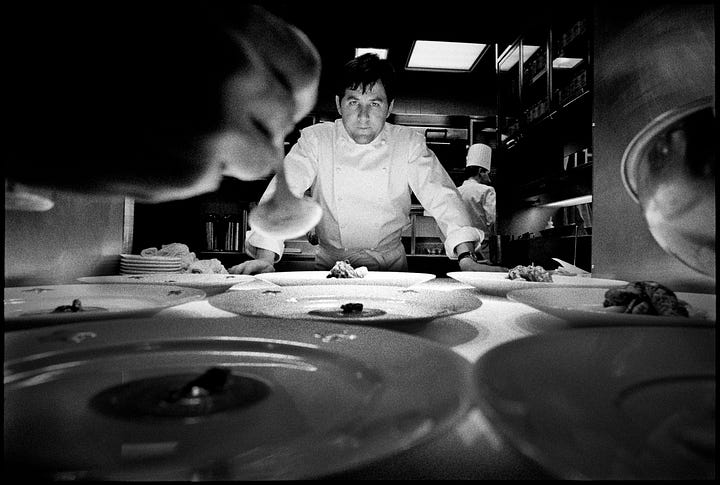
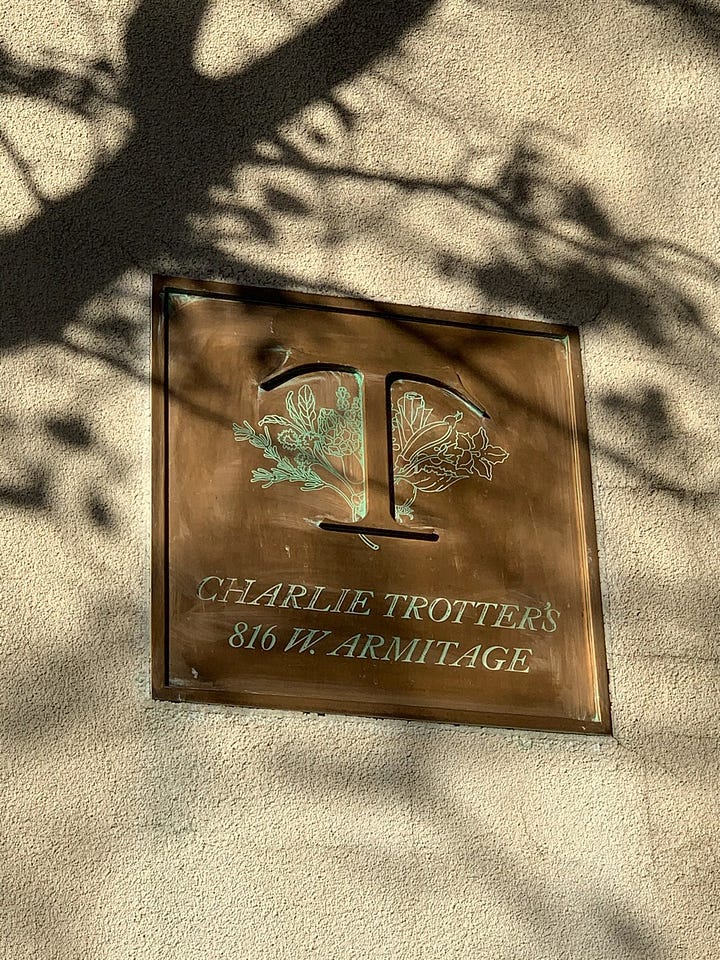
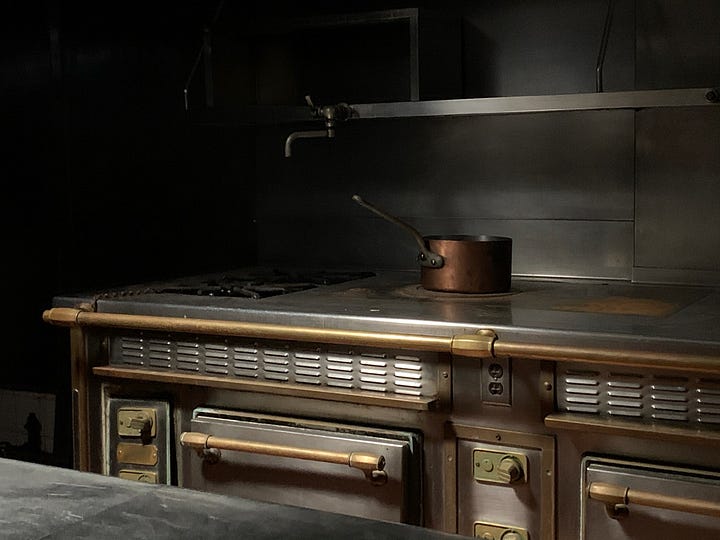
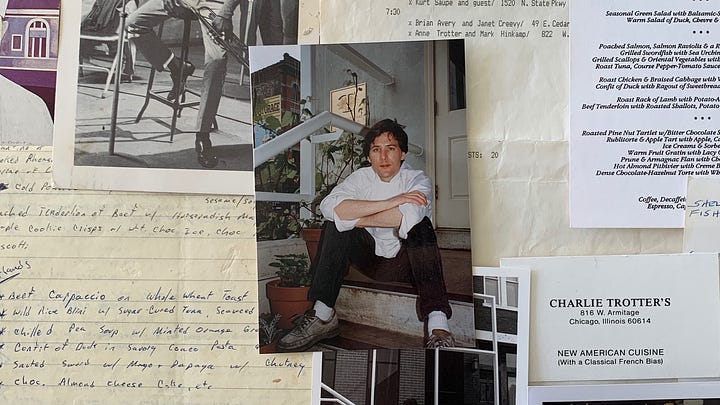
Two class actions brought against Trotter in 2003 by employees for alleged violations of labour law were perhaps a turning point in Trotter’s fortunes and led to enmity towards former employees, including future multi-Michelin-starred chef Curtis Duffy. Molecular gastronomy blindsided Trotter who found himself no longer the leader of the pack, and called Achatz’s food at the critically acclaimed Alinea restaurant ‘nonsense on stilts’. Achatz says that, ‘At that point, he was my enemy.’
Spolier alert: there is no happy ending in Love, Charlie, but it’s nevertheless appointment viewing for restaurant fanatics. Trotter is given the respect his achievements in gastronomy deserve, but the documentary pulls no punches in telling his fascinating story. Will you love Charlie by the end of the film? There’s only one way to find out.
Love, Charlie is available to stream now on UK platforms. Use the following affiliate link to rent the movie on Amazon Prime and help support Smashed: watch the film.
Something to drink: Cocktail recipes from The Curious Bartender’s Agave Safari by Tristan Stephenson
Sales of tequila in the UK are booming, according to the magazine for the licensed trade, The Morning Advertiser, so the publication of master mixologist Tristan Stephenson’s latest book, Agave Safari, is well timed. Stephenson, known for his popular series of The Curious Bartender books, of which this is the latest, travelled across Mexico, visiting 38 agave spirits producers in Jalisco, Los Altos, Michoacán and Oaxaca.
The result is as comprehensive a survey of the subject of tequila, mezcal and raicilla (‘the latest regional spirit of Jalisco to be officially baptised with its own legal designation of origin (DO)’) as you are likely to find. Producers include Patron, Jose Cuervo, Calle 23 and Arette among many others. Agave aficionados may be disappointed to discover that Stephenson did not travel north to Sonora to visit any bacanora producers, but maybe that’s a trip for another book. For those that are not familiar with the spirit (I certainly wasn’t) bacanora was awarded its DO in 2000 and ‘has become Sonora’s most renowned distillate, made exclusively with Agave angustifolia.’
Did you know that there is a town called Tequila? That tequila used to be known as vino de mescal de Tequila because it’s just ‘one of countless regional agave spirits produced in Mexico’? That there are 300 identified species of agave, but tequila is made only with blue Weber agave that grows to 6ft high and 6ft wide? You will do if you read Agave Safari, and that’s just on the first page.
Part primer, part travelogue, Stephenson reveals the world of agave spirits over the course of his weeks-long journey, stopping in at producers and bars along the way. You’ll often find him bumping along bad roads, driven by his guide Pancho. It’s like a tequila-based version of Fear and Loathing in Las Vegas but without the hallucinations. Sort of.
It’s a very deep and nerdy dive into the detail of agave spirit production, but a fascinating one too. The knowledge you acquire by reading the book will also help you pick the right bottle. For example, Stephenson decries the use of diffusers rather than more traditional brick oven or autoclave (‘a cylindrical steel oven that looks a bit like a the fuselage of an aircraft’) to process agave. While diffusers are more efficient, Stephenson argues, ‘the end product contains little of the aromatic properties that we associate with tequila’ (you can check the production process of many tequilas at tequilamatchmaker.com).
This is not primarily a tequila cocktail book, there are just 17 mostly very simple recipes (two of which are reproduced below). But if you want to know your reposado (tequila aged for two months to a year) from your anejo (aged for one to three years) and get a real taste of tequila country, then Agave Safari is for you.
The recipes
Margarita
Like most classic cocktails, the margarita has around half a dozen origin stories, none of which come with concrete evidence. In 1938, Carlos “Danny” Herrera, a bartender at Rancho La Gloria near Tijuana, is said to have created the Margarita for Marjorie King, a customer who could only drink tequila. In 1941, Don Carlos Orozco at Hussong’s Cantina in Ensenada allegedly made the drink for Margarita Henkel, naming it after her. In 1948, Margarita Sames, a wealthy Dallas socialite, claimed she invented the cocktail at her Acapulco vacation home. Each story shares a common theme: tequila, lime and orange liqueur coming together in Mexican or border town settings to create a refreshing cocktail for a specific patron or occasion. One thing that seems clear is that the margarita evolved from the “Daisy” family of cocktails which go back well into the 19th century and comprised spirit, citrus and sweetener usually in the form of maraschino (cherry) liqueur, grenadine, or orange curaçao.
For preparation, the margarita is unique in its use of a salt rim. It isn’t essential for the cocktail to work, but if you are using salt it is imperative to use flakes rather than fi ne table salt, as they tend to be softer in their delivery and more pleasing on the lips. A classic 2:1:1 ratio of tequila, curaçao and lime juice is a versatile template, adaptable to most brand combinations, but you can dial any of the components up or down.
40ML RESERVA DE LOS GONZALEZ BLANCO
20ML CURA.AO
20ML FRESH LIME JUICE
Shake all the ingredients with ice and strain into a chilled coupe glass. Salt rim optional.
Sangrita
Originally the sangrita was made from the leftover juices from pico de gallo salsa, which varies from place to place, but is typically made using tomato, onion, lime, salt and chilli. The salt causes the juices to leach out of the ingredients and you end up with an intensely flavoured liquid at the bottom of the bowl. Rather than waste it, someone came up with the idea of sipping it alongside a tequila and the sangrita (the diminutive form of sangre, meaning “blood”) was born.
A sangrita is therefore traditionally served in a small glass alongside a shot of tequila, with the two being sipped alternately. This combination allows the drinker to appreciate the contrasting yet somehow harmonious flavours of the tequila and the sangrita. To be honest, this is how I fell in love with drinking tequila in my twenties. I found that the sangrita refreshed the palate wonderfully between each sip and thus elevated the character of the agave in the spirit. Also, if your sangrita is especially spicy, the tequila can even serve as the antidote to the heat! There’s also something to be said for a ceremony in drinking – something that demands an order or process to the imbibing – and this one beats any slammer or salt-and-lime ritual every time.
Because salsas vary so much in their preparation, the sangrita does too. I would say that chilli, lime and salt are essential but that basically anything else goes. Redness used to be a requirement, which was typically achieved via tomato juice, Clamato juice or, my preference, fresh pomegranate juice. Some people like to put orange juice in there too, and more recently we have started to see green sangritas, which can include cucumber, celery, apple, pineapple and fresh coriander in their recipes. The most important rule, however, is that the sangrita is fresh.
400ML FRESH POMEGRANATE JUICE
200ML FRESH ORANGE JUICE
100ML FRESH LIME JUICE
50ML AGAVE NECTAR
CHILLI POWDER, TO YOUR TASTE
LARGE PINCH OF SALT
MAKES 750ML
Recipes extracted from:
Use the following link to buy this book and support Smashed:
The Curious Bartender’s Agave Safari: Discovering and appreciating Mexico’s tequilas, mezcals & more by Tristan Stephenson
£25, Ryland Peters & Small


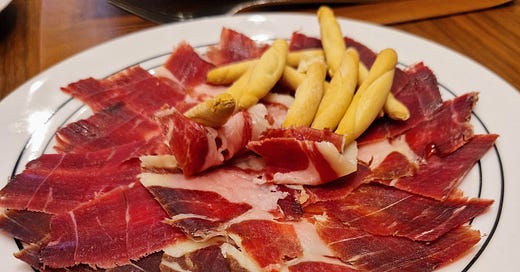



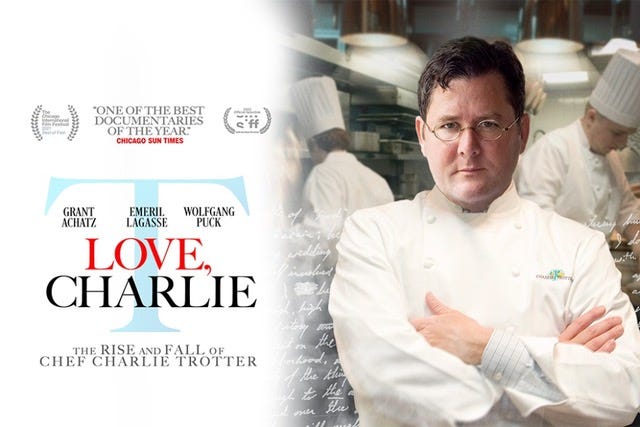
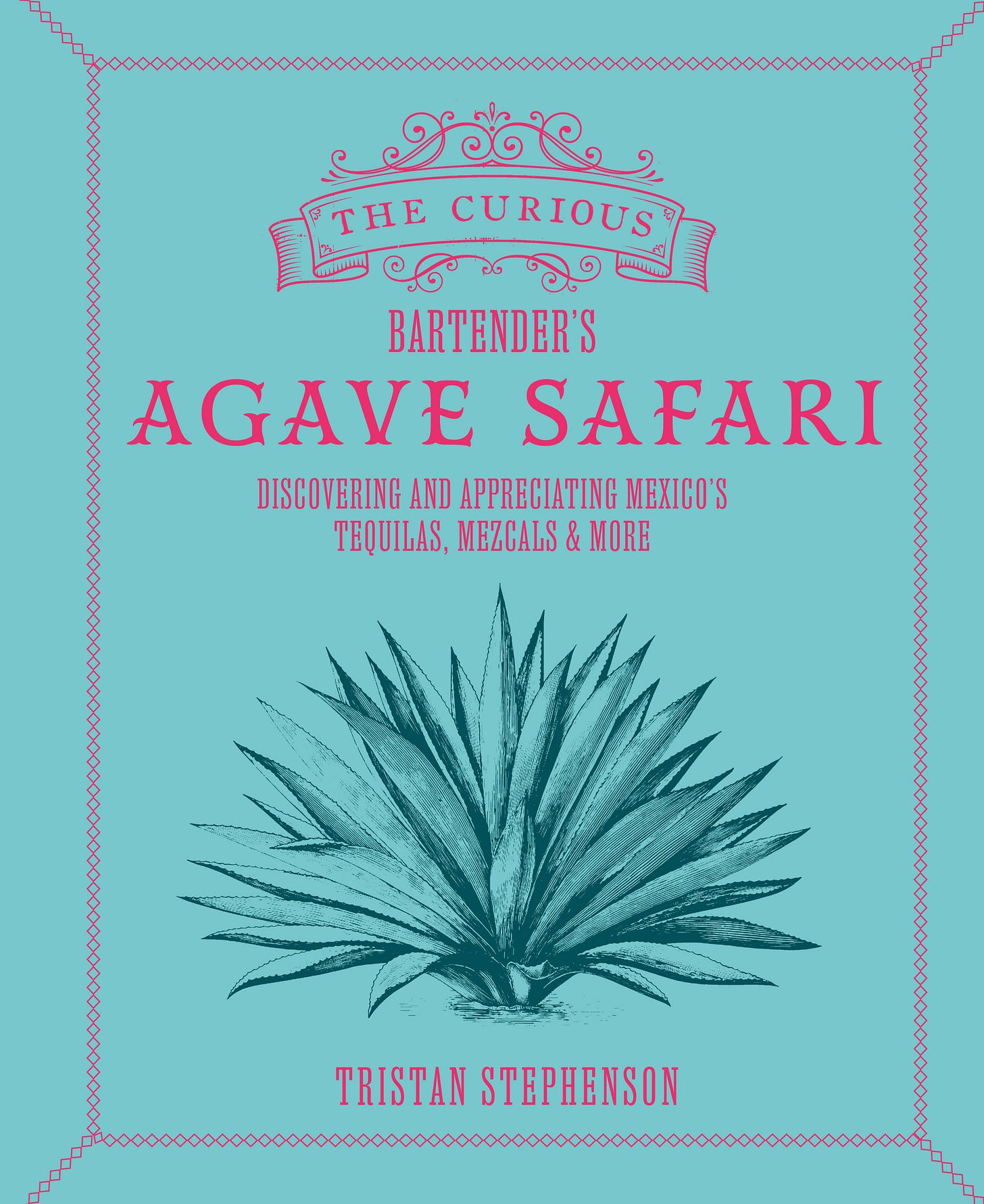

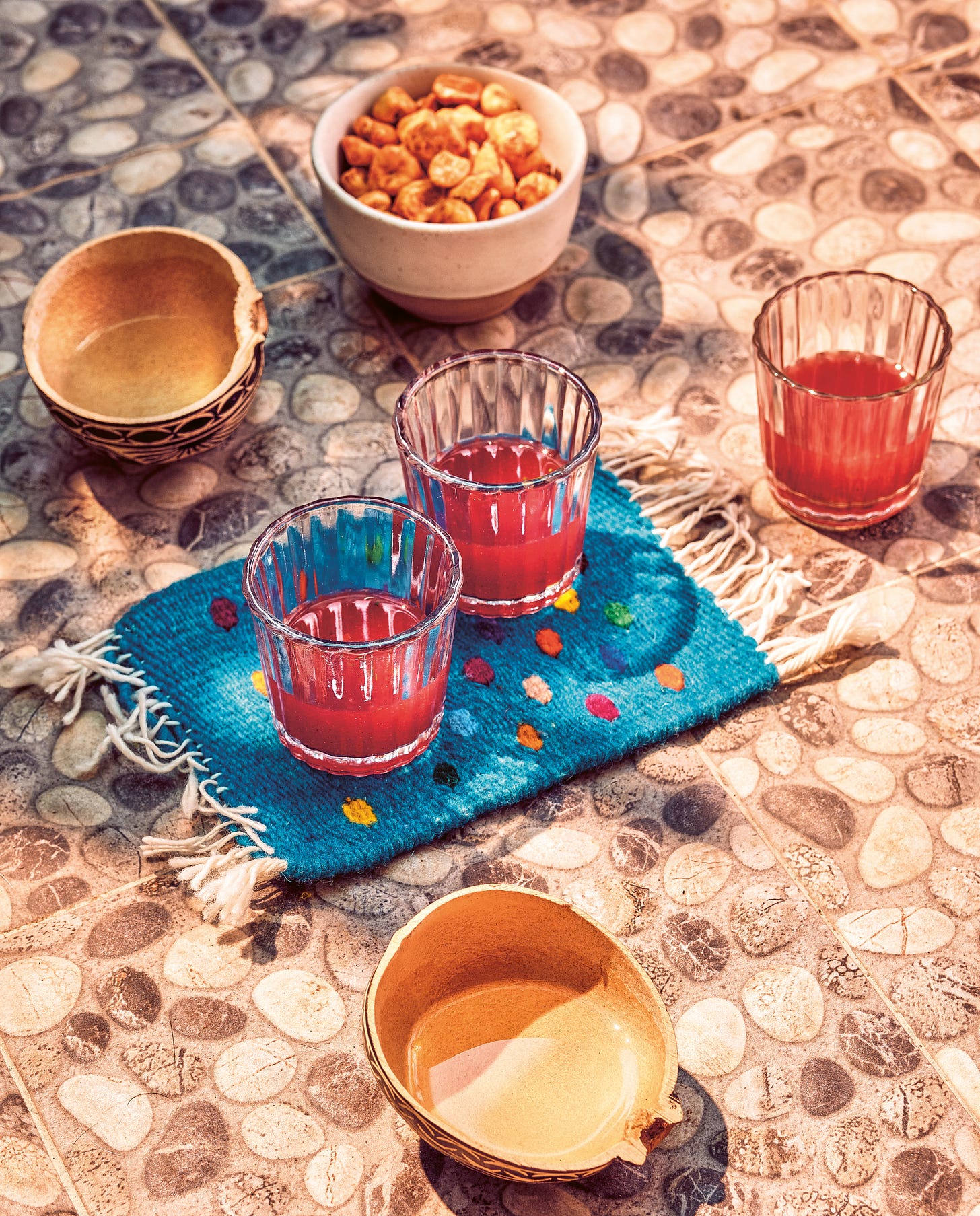
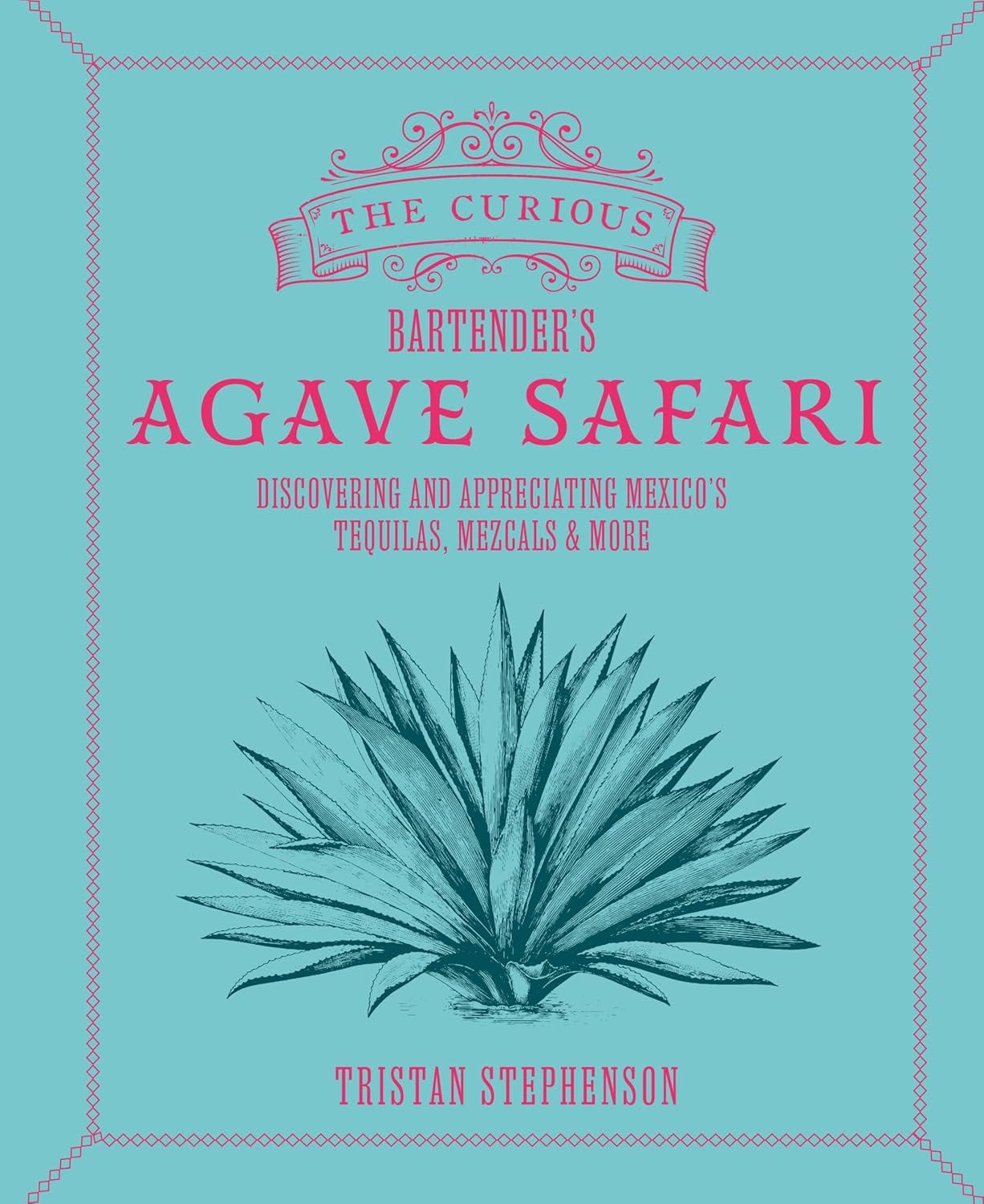
Andy. Thank you very much for pointing your subscribers to my newsletter. And even more for showcasing, my dear friend as well as the beautiful documentary, “Love, Charlie”.
Did you read the Achatz autobiography Andy? Very good.